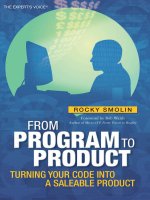Wiley changing software development learning to become agile mar 2008 ISBN 047051504x pdf
Bạn đang xem bản rút gọn của tài liệu. Xem và tải ngay bản đầy đủ của tài liệu tại đây (1.87 MB, 261 trang )
Changing Software
Development:
Learning to be Agile
Allan Kelly
Changing Software
Development
Changing Software
Development:
Learning to be Agile
Allan Kelly
Copyright Ó 2008
John Wiley & Sons Ltd, The Atrium, Southern Gate, Chichester,
West Sussex PO19 8SQ, England
Telephone
(þ44) 1243 779777
Email (for orders and customer service enquiries):
Visit our Home Page on www.wiley.com
All Rights Reserved. No part of this publication may be reproduced, stored in a retrieval system or transmitted
in any form or by any means, electronic, mechanical, photocopying, recording, scanning or otherwise, except
under the terms of the Copyright, Designs and Patents Act 1988 or under the terms of a licence issued by the
Copyright Licensing Agency Ltd, 90 Tottenham Court Road, London W1T 4LP, UK, without the permission in
writing of the Publisher. Requests to the Publisher should be addressed to the Permissions Department, John
Wiley & Sons Ltd, The Atrium, Southern Gate, Chichester, West Sussex PO19 8SQ, England, or emailed to
, or faxed to (þ44) 1243 770620.
Designations used by companies to distinguish their products are often claimed as trademarks. All brand names
and product names used in this book are trade names, service marks, trademarks or registered trademarks of their
respective owners. The Publisher is not associated with any product or vendor mentioned in this book.
This publication is designed to provide accurate and authoritative information in regard to the subject matter
covered. It is sold on the understanding that the Publisher is not engaged in rendering professional services. If
professional advice or other expert assistance is required, the services of a competent professional should be
sought.
Other Wiley Editorial Offices
John Wiley & Sons Inc., 111 River Street, Hoboken, NJ 07030, USA
Jossey-Bass, 989 Market Street, San Francisco, CA 94103-1741, USA
Wiley-VCH Verlag GmbH, Boschstr. 12, D-69469 Weinheim, Germany
John Wiley & Sons Australia Ltd, 42 McDougall Street, Milton, Queensland 4064, Australia
John Wiley & Sons (Asia) Pte Ltd, 2 Clementi Loop #02-01, Jin Xing Distripark, Singapore 129809
John Wiley & Sons Canada Ltd, 6045 Freemont Blvd, Mississauga, ONT, Canada L5R 4J3
Wiley also publishes its books in a variety of electronic formats. Some content that appears in print may not be
available in electronic books.
Library of Congress Cataloging-in-Publication Data
Kelly, Allan, 1969Changing software development : learning to become agile / Allan Kelly.
p. cm.
Includes index.
ISBN 978-0-470-51504-4 (pbk. : alk. paper)
1. Agile software development. I. Title.
QA76.76.D47K454 2008
005.3–dc22
2007035526
British Library Cataloguing in Publication Data
A catalogue record for this book is available from the British Library
ISBN: 978-0-470-51504-4 (paperback)
Typeset in 10.5/13 Times Roman by Thomson Digital, Noida, India.
Printed and bound in Great Britain by Antony Rowe, Chippenham, Wiltshire
This book is printed on acid-free paper responsibly manufactured from sustainable forestry
in which at least two trees are planted for each one used for paper production.
To Taissia for all her support, understanding and
help with this book and everything.
To Mrs. Blyth, Mrs. McQueen, and all the other staff
at Orrets Meadow School for teaching me to read and write all over again. Sometimes you
don’t get it right the first time. You unlearn and start all over again.
Contents
Preface
Acknowledgements
xiii
xv
1 Introduction
1.1 Why Read this Book?
1.1.1 Learning for Agility
1.1.2 Learning Creates Competitive Advantage
1.1.3 Good People Like Learning
1.2 Who are Software Developers?
1.3 Software Developers are Knowledge Workers
1.4 Drucker’s Challenge
1.5 The Prototype of Future Knowledge Workers
1.6 Software: Embedded Knowledge
1.7 Authority and Leadership
1.8 Practical Theory
1.9 Begin with Yourself
1.10 The Organization of the Book
1
2
3
3
4
4
6
8
8
10
10
11
13
14
2 Understanding Agile
2.1 The Roots of Agile Thinking
2.2 Positioning Agile
2.2.1 What is Lean?
2.2.2 What is a Learning Organization?
2.3 Common Practices of Agile Teams
2.3.1 Quality
2.3.2 Business Priorities
2.3.3 Design
2.3.4 Predictable Schedules and Time Boxes
17
18
21
23
24
24
25
27
27
28
viii
Contents
2.4
2.5
2.3.5 Feedback and Communication
2.3.6 The New Bargain
Applicability Outside of Software Development
Conclusion
29
30
33
34
3 Knowledge
3.1 The Difference Between Knowledge and Information
3.2 Knowledge into Action
3.3 Explicit and Tacit Knowledge
3.4 Sticky Knowledge
3.5 Problems with Knowledge
3.5.1 Knowledge Can’t be Mass-produced
3.5.2 Knowledge Flows
3.5.3 The Uniqueness of Knowledge
3.5.4 Business Strategy and the Form of the Organization
3.6 Where is Knowledge in Software Development?
3.6.1 Codification
3.6.2 Specification
3.6.3 Hand-over
3.6.4 The Documentation Myth
3.7 Knowledge Creation
3.8 Conclusion
35
35
37
39
41
43
43
44
45
45
46
47
48
48
49
50
51
4 Learning
4.1 Three Knowledge Domains
4.2 Developing Software is Learning
4.3 Learning Benefits Your Business
4.4 Learning Theories
4.4.1 Single-loop and Double-loop Learning
4.4.2 Learning Styles
4.5 Learning, Change, Innovation and Problem Solving
4.6 The Role of Leaders
4.7 Seed Learning
4.7.1 Personal Reflection
4.7.2 Training Courses
4.7.3 Talk Programmes
4.7.4 Conferences
4.7.5 Company Libraries
4.7.6 Book Study Groups
4.7.7 Wikis
4.7.8 Blogs
4.7.9 Searchable Intranets
53
53
55
55
57
57
60
65
66
67
68
70
70
71
71
71
72
72
72
Contents
4.8
4.7.10 Welcome Debate
Conclusion
73
74
5 The Learning Organization
5.1 Defining the Learning Organization
5.1.1 Companies Learn Through People
5.1.2 The Role of IT in Organizational Learning
5.1.3 Technology Domination
5.1.4 The Search for Good People
5.2 The Infinite and the Finite Game
5.3 The Layers of the Organization
5.3.1 Trust and Honesty
5.3.2 Slack
5.4 Learning in Practice: Senge’s View
5.4.1 Personal Mastery
5.4.2 Shared Vision
5.4.3 Team Learning
5.4.4 Mental Models
5.4.5 Systems Thinking
5.4.6 And Reflection
5.5 Blocks to Learning
5.5.1 Invisibility
5.5.2 Camouflage
5.5.3 Personal Defences
5.5.4 Micro-projects and Solo Developers
5.5.5 Resource Pools
5.5.6 Failure to Act
5.6 Conclusion
75
76
77
79
80
81
82
83
85
86
87
87
88
89
90
92
93
94
94
95
96
98
100
101
102
6 Information Technology – the Bringer of Change
6.1 Change
6.2 Benefits of Technology Change
6.3 Change is What IT People do to Other People
6.4 Software Projects Fail: Why are we Surprised?
6.5 Change Starts with Business Requirements
6.5.1 Mistakes
6.5.2 Lack of Skills
6.5.3 Gold Plating and Information Overload
6.5.4 Communication
6.5.5 Mental Models
6.5.6 Tacit Knowledge
6.5.7 Time Passes, Things Change
103
104
105
108
110
111
113
113
114
114
114
115
115
ix
x
Contents
6.5.8 Learning Occurs
6.5.9 Looking for the Problem Changes the Problem
6.5.10 Late Requests are More Valuable
Conclusion
116
117
118
119
7 Understanding Change
7.1 Defining Change
7.2 The Change Spectrum
7.3 Radical Change
7.4 Routine Change in Software Development
7.4.1 Lack of Routine
7.4.2 Consequences
7.4.3 Finding Routine
7.5 Continuous Improvement
7.5.1 Failings of Incremental Change
7.5.2 Failure to go Fast Enough
7.5.3 Failure to go Far Enough
7.6 Charting a Course
7.6.1 Make it Continuous
7.6.2 Going Further
7.6.3 Little Bits of Radical Change
7.6.4 Hard Choices
7.7 Internal and External Forces for Change
7.7.1 Combining Internal/external and Radical/incremental
7.7.2 Choosing Between Radical and Incremental Change
7.8 Conclusion
121
121
122
124
126
128
130
130
131
132
133
134
135
136
136
137
138
138
138
139
140
8 Change Models
8.1 Learning and Change
8.2 Lewin’s Change Theory
8.3 Satir’s Theory of Change
8.4 Kotter’s Model of Change
8.5 Theories E and O of Change
8.6 Appreciative Inquiry
8.6.1 The Change Trap
8.6.2 A Different Approach
8.6.3 Appreciative Inquiry in Use
8.6.4 Aspirational Change
8.7 Models, Models, Models
8.8 Motivating Change
8.8.1 Push-and-pull Motivators
8.8.2 Shared Understanding
141
142
143
145
147
149
150
151
151
152
152
153
154
154
157
6.6
Contents
8.8.3 Blocks to Change
8.9 When Not to Change
8.10 Conclusion
157
159
160
9 Making Change Happen
9.1 Build a Case for Change
9.1.1 Find the Problems and Forces
9.1.2 Finding Problems
9.1.3 Communicate the Problem
9.2 Slack in Action: Make Time and Space for Learning
and Change
9.3 Leading the Change
9.3.1 Create Awareness of the Problem
9.3.2 Create Awareness of Opportunities
9.3.3 Beware Unsolvable Problems
9.3.4 Communicate a Failure
9.3.5 Focus the Team on What Needs to be Done
9.3.6 Explain the Change
9.3.7 Model the Changes Yourself
9.3.8 Ask for Volunteers (Self-selecting Teams)
9.4 Create Feedback Loops
9.5 Remove Barriers
9.6 Conclusion
161
162
162
163
164
10 Individuals and Empowerment
177
10.1 Involve People
10.1.1 Motivation
10.1.2 Time for Listening
10.1.3 Ask People their Opinions
10.1.4 Find and Remove Mental Blocks
10.2 Coaching
10.3 Empowerment
10.3.1 Why Empower People?
10.3.2 How do You Empower Individuals?
10.3.3 The Leader’s Role
10.3.4 How Do You Empower a Team?
10.3.5 Empowerment Takes Time
10.3.6 Empowerment Conflicts
10.4 That Difficult Individual
10.5 Developing the Next Leaders
10.6 Time to Go
10.7 Conclusion
165
166
167
168
169
169
170
171
171
172
173
175
175
178
178
179
179
180
181
183
183
184
186
187
188
188
189
192
193
194
xi
xii
Contents
11 Rehearsing Tomorrow
11.1 Future Memories
11.2 Planning
11.2.1 What’s the Problem with Traditional Planning?
11.2.2 Planning as Learning
11.2.3 Scenario Planning
11.3 Change Events
11.3.1 Improvement Meetings
11.3.2 Improvement Worksheet
11.3.3 Process Miniatures
11.3.4 Retrospectives
11.3.5 Workout
11.3.6 Kaizen and Kaikaku
11.3.7 Frequency
11.4 Outsiders
11.4.1 Consultants
11.4.2 Training
11.4.3 Facilitators
11.4.4 Coaches
11.5 Conclusion
195
196
197
199
202
203
205
205
206
206
207
208
210
211
211
212
213
214
215
215
12 New Beginnings
12.1 The Change Problem
12.2 Bottom-up Over Top-down
12.3 Begin with Yourself
12.3.1 Warnings
12.3.2 Legitimacy
12.3.3 In a Lonely Place
12.4 Make Learning Happen
12.5 Create a Vision, Draw up a Plan
12.6 Three Interlocking Ideas
12.7 Change Never Ends
12.8 Conclusion
217
218
219
219
220
220
221
223
224
226
227
228
Further Reading
229
References
231
Index
235
Preface
This book contains two ideas. The first idea is practical and the second more
philosophical, but both are essential if we realize the potential of information
technology to transform business.
The first is about changing your development team. In the short to medium
term, the focus is on making your team Agile. In the longer term, its about
making your team into a learning team, capable of learning, changing and
improving itself. Such teams are true Agile teams.
Improving the software development process has always been difficult. In
part, its difficult because we havent known how to do it, and in part its
difficult because any kind of change is hard. Today, we have good models of
how to do software development. The Agile community has demonstrated
techniques that work. These techniques and ideas are well documented.
Consequently, the problem that we face today is less How shall we develop
software? and more How do we move from the way we do things today to a
more Agile way?
The second idea in this book is a call for us to change the dominant view of
software development. Traditionally, software development has been considered an engineering discipline – something to be planned, scheduled and
executed. The view presented here considers the process of developing software as an exercise in learning and knowledge creation.
Both ideas are based on a very simple theory: it isnt enough to learn facts
alone. For learning to be meaningful, we must take action on what we learn.
Learning with action means change, so learning and change are two sides of the
same coin.
Acknowledgements
There are many people who I need to thank for helping me directly, and
indirectly, to write this book. First and foremost, I must thank Taissia, who not
only read the final manuscripts but, more importantly, allowed me the time to
write the book.
Many thanks go to the reviewers – Alan Griffiths, Liz Sedley, Jonathon Sefton,
Rachel Davies and Giovanni Asproni – and to Nicki Kelly for additional editing.
I am indebted to John Merrells, who as ACCU Overload editor encouraged my early attempts at writing. For over four years, John published
most of what I wrote, helped me improve and allowed me to move away
from technical topics into more reflective management topics. Thanks again
to Alan Griffiths, who took over as Overload editor when John stepped
down.
Thank you to the many members of the ACCU for good conversations and for
acting as unknowing guinea pigs for the ideas in this book. Attentive readers
will find the prototype of this book in the pages of Overload.
In particular, I must thank Kevlin Henney, who introduced me to Pattern
writing and to the Pattern community. Although Patterns are not the topic of
this book, I have learned much through Pattern writing. So I must thank the
Hillside, EuroPLoP and VikingPLoP communities for all the indirect help they
have given to this project.
In 2002, I took a year out from IT to attend Nottingham University Business
School. As well as being introduced to many new ideas, I also had the chance to
rethink the whole software development domain: to everyone at NUBS, and the
class of 2002–3, many thanks to you all. In particular, I would like to thank
Professors Ken Starkey and John Richards – anyone familiar with their ideas
and teaching will spot their influence in this book.
If you are wondering where to get inspiration and good conversation on
the topics raised here, I can recommend that you join the ACCU, get
xvi
Acknowledgements
involved with the Patterns community or take yourself off to business
school.
No book would exist without a publisher. I would like to thank everyone at
John Wiley & Sons, Ltd, for their efforts in bringing this book to publication; in
particular, Andrew Kennerly, Sally Tickner, Lynette James and especially Rosie
Kemp.
CHAPTER
1
Introduction
‘‘We understand that the only competitive advantage the company
of the future will have is its managers’ ability to learn
faster than then their competitors.’’
Arie de Geus (1988)
Software development, in all its forms, is an exercise in learning. Learning occurs
within the teams that develop the software – not just the amongst the managers.
Then learning occurs with the people who use the software. If we exploit this
learning, we can enhance the competitive advantage for our companies.
In order to recognize the value of learning, it’s necessary to change things: to
change what we do and the way we do it. Without change we can’t truly learn,
and we certainly don’t exploit our learning. The process of learning and
changing is an exercise in knowledge creation. Knowledge itself is learning
with action: this action often manifests itself as change. This idea, summarized
in Figure 1.1, runs through this book.
Knowledge is the underpinning of our modern economy – hence the
knowledge economy – and IT is a key part of this economy. Modern IT
wouldn’t be what it is without software, and that software needs to be written.
Yet the people who develop software, and those who manage them, seldom talk
about knowledge and the role that IT can play in enhancing learning. All too
often, we prefer to view software development as some sort of factory production line process.
This view runs far beyond the development process. Organizations buy
software and other IT products in order to create change. Introducing the
Changing Software Development: Learning to Become Agile
Ó 2008 John Wiley & Sons, Ltd.
Allan Kelly
1
2
Chapter 1
Knowledge = Learning + Action
Figure 1.1
Knowledge is.
software creates change for the users, and subsequent changes to the software
create more change.
Today’s software developers and their managers face three major forms of
change. Firstly, there’s the need to adopt Agile methods. Agile and Lean
development techniques are now established and are moving into the mainstream arena. In order to adopt these techniques, development teams must
change the way in which they work.
Secondly, having adopted Agile development, these best-performing teams
need to move far beyond the current methods and best practices. Before long,
simply adopting the prescribed practices of a methodology such as eXtreme
Programming won’t be enough. Each team must learn for itself what works best.
Finally, IT is all about creating change in others. IT deployments that inflict
change on helpless users don’t recognize the true benefits of IT; indeed, many
such projects are outright failures. Those developing and deploying software
must appreciate the need for change and learning by the end users.
Learning and change are complicated fields. All too often, people see change as
the simple application of raw authority: tell someone to do it differently, tell someone
to use a new system, punish them if they get it wrong. Unfortunately, this technique
doesn’t work very well. In particular, it isn’t effective with knowledge workers
who may actually know more about the problem than anyone in a position of
authority. So we need a new view of change to help us with these problems.
Fortunately, the best people in IT – and, in particular, the actual software
development side – like learning. Much, if not most, IT work is problem solving,
which is itself a form of learning. Therefore, we need to help people learn, help
them learn the right things and ensure that this learning is maximized through
meaningful change.
1.1 Why Read this Book?
Even if you don’t wish to embrace Agile software development, there are good
reasons to embrace learning and create a learning culture. Building a learning
environment and culture can help improve the way in which you create
software and benefit your company in many ways.
This book is primarily written for software developers and managers who
want to improve the way in which they, and their teams, develop software.
Software developers who are making, or have recently made, the transition to
team leadership and development management should find the ideas particularly interesting.
There’s an additional group of people who I hope will find this book
interesting: those dependent on the work of a software development team.
Introduction
Such people often view IT, and specifically development activities, as a foreign
land. Viewing IT as a learning activity, rather than an engineering or scientific
activity, can help explain much of what goes on in that land.
1.1.1 Learning for Agility
The book aims to help in three ways:
&
For teams that want to be Agile: Increasingly, we know what Agile software
development is. The problem facing those who aren’t Agile is not What is
Agile? or What do Agile teams do differently? The problem is rather
How do we change so that we’re Agile? This book presents learning as a
mechanism for creating change.
&
For teams that are Agile and want to improve further: For teams that have
achieved Agility, the challenge is slightly different. Such teams will
already be seeing the benefits of the Agile approach. However, there’s
still a need to improve and become even better. The learning-based
approach can help here too.
&
By explaining the role of learning in software development: During the past
40 years, there have been many attempts to make software development fit
within the engineering and process metaphors. Despite this, software
projects have continued to fail. In this book, I suggest that software
development is an exercise in learning and knowledge management.
Changing our perspective offers new insights and approaches. In particular, this perspective allows us to harness the tools and experience of the
organizational learning movement instead of the tools of engineering.
This book doesn’t attempt to be the last word on any of these subjects. I’ve tried
to point you to many sources for further investigation. Instead, this book aims,
firstly, to introduce each of these topics and, secondly, to weave them into a
coherent narrative to explain software development as a learning activity.
1.1.2 Learning Creates Competitive Advantage
Modern business is constantly searching for competitive advantage: the ability
to out-compete rivals, to sell more products, to sell more expensive products
and to increase production. Once upon a time, competitive advantage could be
gained by having better physical access than your competitors to some resource, land, labour or capital.
Today, firms seek competitive advantage through better access to knowledge
and by their ability to act on this knowledge. Knowledge is the result of
learning; therefore, as suggested in the opening quote, a firm’s ability to learn
may be its only competitive advantage.
3
4
Chapter 1
By learning, we’re able to create better products: we learn more about our
customers, we learn more about the technology our products are built from and
we learn how to produce the products more efficiently. Using this learning,
we’re able to improve our products. Learning about our customers, products
and manufacturing process may allow us to create better products.
Learning also allows us to increase our productivity. Through learning,
we’re able to build products faster, more efficiently and with less waste. This
allows us to maximize the returns from our investment – whether capital or
workers’ time – and generate more profit. In these cases, the firm’s ability to
learn is key to helping the firm improve and succeed. The firm that learns
fastest wins.
But learning isn’t just essential in order to win: it’s also essential in order to
survive. Modern businesses exist in a changing environment, new competitors
enter markets, customer expectations change, and technologies and regulations
change. Firms that don’t learn and adapt to a changing environment may not
survive.
So, learning isn’t an optional extra. Firms and individuals must learn if they
are to survive. For those that master learning and can learn faster than others,
there are rewards.
1.1.3 Good People Like Learning
Humans are natural learners. Our ability to learn faster than many other
animals is one of the reasons why we humans have advanced as far as we
have. Within software development, those who enjoy and excel at learning tend
to perform better than those who dislike learning new things. There are always
new technologies and application domains to learn. Anyone who dislikes
learning would be well advised to avoid a career in software development.
The search for competitive advantage outlined above isn’t the only reason to
embrace learning. People who enjoy learning are more motivated when given
an environment in which they can learn more. Motivated people get more job
satisfaction and are more productive.
Naturally, when people are motivated and happy with their work they are
more likely to remain with the same employer. Therefore, creating a learning
environment should help improve staff retention. Recruitment may also
become easier, as word spreads of a positive work environment, filled with
motivated people who are learning new things.
1.2 Who are Software Developers?
The term software developer is most often used to describe the engineers who
write program code. In truth, there are many more roles necessary to develop
software: testers, business analysts, designers, product managers, architects,
Introduction
deployment specialists, project managers, development managers and others
all have a hand in developing the software.
The IT community doesn’t have a standard set of job titles and pre-defined
roles; what one company calls a product manager is an architect elsewhere,
one company’s project manager is another’s development manager, a team
leader in one is a manager in another, and so on. All these people are in some
way contributing to the development of a software system.
The level of knowledge and experience required to develop a successful
system causes the old blue-collar/’white-collar’ division to fade. Someone
who thinks of a programmer as analogous to a factory worker is making a
mistake: the level of knowledge required by a programmer is several orders of
magnitude greater than that required by an assembly line worker.
The profile of a modern development team looks more like a group of whitecollar managers than a set of blue-collar workers: highly skilled people with
specific knowledge who spend their days making informed decisions – not to
mention working in air-conditioned offices. Consequently, when looking
outside the IT arena, research, advice and inspiration are often to be found
in texts that discuss management challenges.
Thinking Point: Why Do You Want To Change?
This book is going to discuss changing the way in which you create
software. Specifically, I’m going to describe how you can help your team
adopt Agile software practices. Before getting stuck into the task in hand,
it is worth taking a step back and asking: Why? – Why do we want to change
the way in which we do things?
Before you read any further, put this book down and make a list of five
reasons why you’d like to change the way in which your organization
develops software:
&
Try to think beyond immediate reasons such as a recently failed
project.
&
Try to think about why, not what.
&
Try to think about big reasons rather than small ones.
&
Try to think about your company as a whole rather than just your
team: What benefit will this bring?
&
Be honest: if you want to change the team to further your own career,
recognize it – you don’t have to tell anyone else.
You might also want to think about the opportunities that you can see if
you can change.
Now that you’ve made the list, put it to one side. (If you want to hide it,
do so!)
5
6
Chapter 1
There are various reasons why you might want to change your development practices. Here are a few reasons, all of them legitimate:
&
To improve the competitiveness of your team or company.
&
To improve the quality of your software.
&
To increase the productivity of your team.
&
To create new business opportunities, products and/or services.
&
To address a problem that you’re having today.
&
To save your own job, perhaps by preventing your work being
outsourced and/or sent off shore.
&
To better serve the business.
&
To enjoy your job more.
This isn’t an exhaustive list; nor are the items in the list distinct – they all
overlap. Depending on your situation, some will be cause and others
effect: improving the quality may allow you to support your business
better and prevent your department being outsourced, thereby saving
your job.
In fact, everything could be reduced to the first item: improve company
competitiveness. However, this is so general as to be of little use. Most of the
other reasons can be reduced to either quality or productivity, but to do so
means losing useful information about motivation.
1.3 Software Developers are Knowledge Workers
If we look at the definition of knowledge workers, it is clear that it includes
developers:
‘‘Knowledge workers have high degrees of expertise, education, or experience, and the primary purpose of their jobs involves the creation, distribution, or application of knowledge.’’
Thomas Davenport (2005)
Indeed, writers and experts on the knowledge economy and knowledge
workers frequently cite software developers, and IT people in general, as prime
examples of knowledge workers. These are individuals who work primarily
with their knowledge. Yet it is rare for those in IT, or writers about IT, to discuss
software developers as knowledge workers. But then: Why would they? What
difference does it make?
This book will argue that by viewing software developers as knowledge
workers, and considering development activities as knowledge creation with









